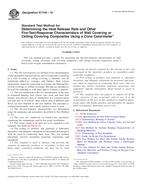Potrebujeme váš súhlas na využitie jednotlivých dát, aby sa vám okrem iného mohli ukazovať informácie týkajúce sa vašich záujmov. Súhlas udelíte kliknutím na tlačidlo „OK“.
ASTM E1740-10
Standard Test Method for Determining the Heat Release Rate and Other Fire-Test-Response Characteristics of Wall Covering or Ceiling Covering Composites Using a Cone Calorimeter
Automaticky preložený názov:
Štandardná skúšobná metóda pre stanovenie miery uvoľňovanie tepla a ostatné požiarnej-Test-Response Charakteristika obloženie stien a stropov Krycie kompozitov s použitím Cone kalorimetri
NORMA vydaná dňa 1.8.2010
Informácie o norme:
Označenie normy: ASTM E1740-10
Poznámka: NEPLATNÁ
Dátum vydania normy: 1.8.2010
Kód tovaru: NS-42847
Počet strán: 12
Približná hmotnosť: 36 g (0.08 libier)
Krajina: Americká technická norma
Kategória: Technické normy ASTM
Anotácia textu normy ASTM E1740-10 :
Keywords:
calorimeter, ceiling covering, fire, fire-test response, heat release, ignition, oxygen consumption, small scale, wall covering, Wallcovering materials/applications, Ignition--building materials, Laminates (adhesive applications), Adhesives, Calorimeter, Coatings, Composites, Cone calorimeter, Fire testing--building materials, Heating tests--building products, Heat release, Oxygen consumption, ICS Number Code 13.220.50 (Fire-resistance of building materials and elements)
Doplňujúce informácie
| Significance and Use | ||||||||||||||||||||
|
This test method is used to determine the time to sustained flaming and heat release of materials and composites exposed to a prescribed initial test heat flux in the cone calorimeter apparatus. Quantitative heat release measurements provide information that can be used to compare wall or ceiling coverings and constructions and for input to fire models. Heat release measurements provide useful information for product development by giving a quantitative measure of specific changes in fire performance caused by component and composite modifications. Heat release data obtained by this test method will be inappropriate if the product will not spread flame over its surface under the fire exposure conditions of interest. Variations in substrates, mounting methods, and adhesives used to laminate composite products will potentially affect the test responses. These variables must be controlled during any comparative experiments. Test Limitations—The test data are invalid if any of the following occur: Explosive spalling, The specimen swells sufficiently prior to ignition to touch the spark plug or swells up to the plane of the heater base during combustion, or The surface laminate rolls or curls when placed under the radiant heater. The specimens are subjected to one or more specific sets of laboratory conditions in this procedure. If different test conditions are substituted or the end-use conditions are changed, it is not always possible by or from this test to predict changes in the fire-test-response characteristics measured. The results are therefore valid only for the fire test exposure conditions described in this procedure. |
||||||||||||||||||||
| 1. Scope | ||||||||||||||||||||
|
1.1 This fire-test-response test method covers determination of the ignitability and heat release rate of composites consisting of a wall covering or ceiling covering, a substrate, and all laminating adhesives, coatings, and finishes. Heat release information cannot be used alone to evaluate the flammability of wall coverings or ceiling coverings. The data are intended to be used for modeling or with other data to evaluate a material. 1.2 This test method provides for measurement of the time to sustained flaming, heat release rate, peak and total heat release, and effective heat of combustion at a constant initial test heat flux of 35 kW/m2. Heat release data at different heat fluxes are also obtained by this test method. The specimen is oriented horizontally, and a spark ignition source is used. 1.3 The fire-test-response characteristics are determined using the apparatus and procedures described in Test Method E1354. 1.4 The tests are conducted on bench-scale specimens combining the components used in the actual installation. 1.5 The values stated in SI units are to be regarded as the standard. See . 1.6 Fire testing of products and materials is inherently hazardous, and adequate safeguards for personnel and property shall be used in conducting these tests. This test method potentially involves hazardous materials, operations, and equipment. 1.7 This standard is used to measure and describe the response of materials, products, or assemblies to heat and flame under controlled conditions, but does not by itself incorporate all factors required for fire hazard or fire risk assessment of the materials, products, or assemblies under actual fire conditions. 1.8 Fire testing of products and materials is inherently hazardous, and adequate safeguards for personnel and property shall be employed in conducting these tests. This test method may involve hazardous materials, operations, and equipment. Specific information about hazard is given in Section 6. 1.9 This standard does not purport to address all of the safety concerns, if any, associated with its use. It is the responsibility of the user of this standard to establish appropriate safety and health practices and determine the applicability of regulatory limitations prior to use. |
||||||||||||||||||||
| 2. Referenced Documents | ||||||||||||||||||||
|




 Cookies
Cookies
